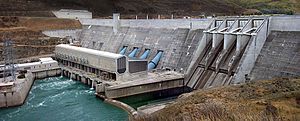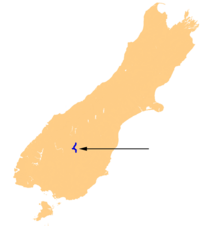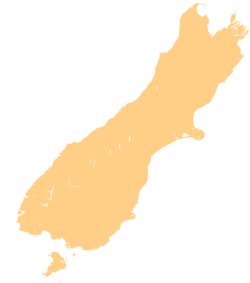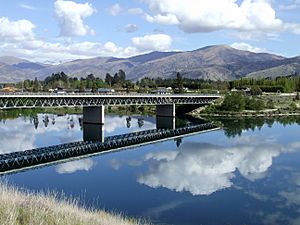Lake Dunstan facts for kids
Quick facts for kids Lake Dunstan |
|
|---|---|

The Clyde Dam
|
|

Lake Dunstan
|
|
| Location | Central Otago District, Otago Region, South Island |
| Coordinates | 45°01′19″S 169°13′05″E / 45.022°S 169.218°E |
| Lake type | reservoir |
| Primary inflows | Clutha River |
| Primary outflows | Clutha River |
| Basin countries | New Zealand |
| Surface area | 26 km2 (10 sq mi) |
Lake Dunstan is a large, man-made lake in the South Island of New Zealand. It was created when the Clyde Dam was built across the Clutha River. This lake is important for farming and offers many fun activities for people to enjoy.
Contents
How Lake Dunstan Was Made
Lake Dunstan was formed on the Clutha River. It was created by building the Clyde Dam. The lake filled up in stages starting in April 1992 and was finished the next year.
Some parts of the town of Cromwell had to be moved. They built new areas for the town above the new lake level. The lake flows through a narrow area called the Cromwell Gorge.
What Lake Dunstan Is Used For
Lake Dunstan helps local farms by providing water for irrigation. This water is used for stone fruit orchards and vineyards.
The lake is also a very popular place for recreation. Many people visit to enjoy the water and scenery. You can find facilities for:
- Boating
- Waterskiing
- Fishing
- Parapenting (a type of paragliding)
- Rowing
Challenges During Construction
The building of the dam and the lake became well known in New Zealand. This was because of problems with the ground during its construction. For example, a landslide happened at Cairnmuir. This area has steep cliffs overlooking the gorge where the dam was built.
Because of the high cost to make the gorge walls safe, this was the last big project of its kind.
Why People Protested
Many people from the local community strongly protested against the dam project. They wanted the plans and construction to stop.
Different groups joined the protests. These included environmentalists, scientists, and lawyers. Also, people who used the river for fun joined in. Families who had lived there for many generations were upset. Others who had recently moved to the area also protested.
Artists played a special role in showing their feelings. They created powerful artworks about the dam issue. These artists included Ralph Hotere, Andrew Drummond, Chris Cree-Brown, and Chris Booth. Their work helped to make the public more aware of the situation.
Other artists also created art about the dam. Robin Morrison took sensitive photos of the residents affected by the flooding. Marilynn Webb made a series of prints called "Good Bye- Clutha Blue" in 1983. Bruce Foster took photos looking at the lines painted on the land before construction. Lloyd Godman created large photo-mural prints. These prints were toned with gold from the Clutha River. He called this series “The Last River's Song”.
As the lake was filling up in 1992–93, Godman also did performance art. He used an underwater camera to take photos of the river. These photos showed how the rising lake level slowly covered the familiar views.



